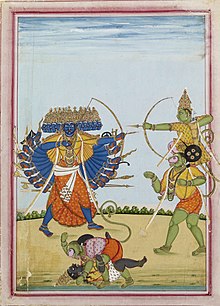Kambaramayanam
The Ramavataram ( கம்பராமாயணம் Kamparāmāyaṇam [ kambəraːmaːjəɳʌm ] "Ramayana of Kamban"), actually Iramavataram ( இராமாவதாரம் Irāmāvatāram [ (ɨ) raːmaːʋəd̪aːrʌm ] "the descent of Rama") is a Tamil version of Ramayana -Epos the poet Kamban probably in the 12th century composed.
The Ramayana
The Ramayana is an epic about Prince Rama , who was born in Ayodhya as the avatara of the god Vishnu . Because of an intrigue, he has to renounce his right to rule and, together with his brother Lakshmana and his wife Sita, go into exile in the forest, where Sita is kidnapped to Lanka by the demon king Ravana . With the help of an army of monkeys led by Hanuman , Rama succeeds in defeating Ravana and freeing Sita. Eventually he returns to Ayodhya and is crowned king.
The oldest version of the Ramayana is the Sanskrit version ascribed to the mythical author Valmiki , which in its oldest parts probably dates back to the 5th century BC. BC and by the 3rd century AD it was essentially the same as it is today. There are also versions of the Ramayana in practically all modern Indian languages. In the Tamil area, the Kambaramayanam is the authoritative version of the Ramayana. It is not the first Tamil Ramayana, but it is the oldest extant, and after Kamban no other Tamil poet wrote a Ramayana (apart from modern prose retellings). Among the modern language versions of Ramayana, the Kambaramayanam can be considered the most important, alongside the Ramcharitmanas , the Hindi version of the poet Tulsidas .
The content and style of the Kambaramayanam
The Kambaramayanam comprises over 12,000 four-line verses. The work is highly poetic and is characterized by a rigid meter , numerous stylistic devices ( alliterations , internal rhymes ) and artificial comparisons. Stylistically it is influenced by the Sanskrit art poetry ( Kāvya ), but also builds on the conventions of classical Tamil poetry, as found in the ancient Tamil Sangam literature .
The Kambaramayanam is based on the model of Valmiki's Ramayana . The plot knows no major deviations from Valmiki's version, and Kamban also takes over the division into books ( Balakanda, Ayodhyakanda, Aranyakanda, Kishkindhakanda, Sundarakanda, Yuddhakanda ) from Valmiki, but the seventh and final book ( Uttarakanda ) is missing compared to Valmiki . In terms of content, the Kambaramayanam differs from Valmiki's Ramayana through the influence of the Bhakti religion, which emphasizes the believer's devotion to God. While Rama still appears as a purely human hero in the oldest parts of the Valmiki- Ramayana , in Kamban's version he is completely deified. There are also some substantive differences due to the bhakti thought: Kamban, in contrast to Valmiki, describes how the demon Ravana, when he steals Sita, lifts her up together with the floor on which she stands. This bypasses the idea that the goddess Sita may have been tainted by the touch of a strange man.
reception
The Kambaramayanam is held in high regard by the Tamils. In premodern times it was one of the works that made up the canon of Tamil literature. The rise of Tamil cultural awareness in the early 20th century (the so-called Tamil Renaissance ) only added to the importance of Kambaramayanam , which was now hailed as one of the greatest achievements of Tamil literature. In contrast, the Tamil nationalist politician CN Annadurai sharply criticized the Kambaramayanam in the 1940s. In his view, Kamban had corrupted the purity of the original " Dravidian " culture of the Tamils by writing a Tamil version of the " Aryan " Ramayana epic. Ultimately, however, the view prevailed to regard the Kambaramayanam as part of the Tamil cultural heritage.
A dramatic version of the Kambaramanyam shortened to around 3200 verses is performed in Kerala in the shadow play Tholpavakuthu in honor of the goddess Bhadrakali.
supporting documents
- ↑ For the dating of Kamban see Kamil Zvelebil: The Smile of Murugan. On Tamil Literature of South India, Leiden 1973, p. 208.
- ↑ On the dating of the Ramayana, see John L. Brockington: Righteous Rāma. The Evolution of An Epic, Delhi 1984, pp. 307-327.
- ↑ Zvelebil 1973, p. 209.
- ^ Stuart Blackburn: Inside the Drama House. Rāma Stories and Shadow Puppets in South India. University of California Press, Berkeley / Los Angeles / London 1996, pp. 28-29.
- ↑ Jonas Buchholz: "Countering Kampaṉ: CN Annadurai's Critique of the Rāmāyaṇa". In: Zeitschrift für Indologie und Südasienstudien 32/33 (2015/2016), pp. 203–232.
literature
- HV hands : Kamba Rāmāyanam. An English Prose Rendering. Mumbai: Bharatiya Vidya Bhavan, 1996.
- Shanti Lal Nagar: Kamba-Rāmāyaṇa. English translation of Tamil Rāmāyaṇa of Sage Kamban. 2 volumes. Delhi: Parimal Publishers, 2008.
- PS Sundaram: Kamba Ramayanam. 6 volumes. Chennai: Department of Tamil Development-Culture, Government of Tamil Nadu, 1989–1994.
- PS Sundaram: Kamba Ramayana. New Delhi: Penguin Books, 2002.
- George L. Hart & Hank Heifetz: The Forest Book of the Rāmāyaṇa of Kampaṉ. University of California Press: Berkley, Los Angeles, London, 1988.
